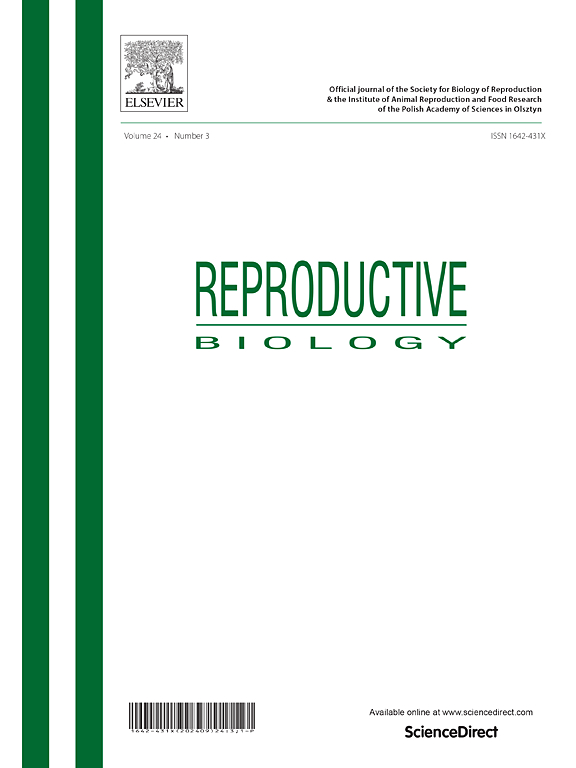Trophoblast-derived factors drive human mesenchymal stem cell differentiation along an endothelial lineage: A model of early placental vasculogenesis
IF 2.5
3区 生物学
Q3 REPRODUCTIVE BIOLOGY
引用次数: 0
Abstract
Mechanisms controlling the process and patterning of blood vessel development in the placenta remain largely unknown. The close physical proximity of early blood vessels observed in the placenta and the cytotrophoblast, as well as the reported production of vasculogenic growth factors by the latter, suggests that signalling between these two niches may be important. Here, we have developed an in vitro model to address the hypothesis that the cytotrophoblast, by the secretion of soluble factors, drives differentiation of resident sub-trophoblastic mesenchymal stem cells (MSCs) along a vascular lineage, thereby establishing feto-placental circulation. BM-MSCs (a readily available model for placental stem cells) were treated with conditioned medium containing the secretome from human BeWo trophoblast cells, or endothelial growth medium (EGM2) supplemented with exogenous growth factors (VEGF, IGF1 and EGF) for 10–12 days. Trophoblast-conditioned media, found to contain detectable concentrations of cytokines including VEGF, uPAR, TIMP-1, TIMP-2, IL6 and placental growth factor, induced the expression of the endothelial genes CD31, von Willibrand factor (vWF), FLT-1, VEGFR2 and VE-Cadherin. Upregulation of vWF protein was also detected following growth in trophoblast-conditioned media, using immunocytochemistry. Wound healing (migration assay) and Matrigel-tube formation assays confirmed that the BM-MSCs cultured in trophoblast-conditioned media exhibited functional measures of endothelial cells in addition to expressing relevant markers. Identification of key trophoblast-secreted factors and their promotion of endothelial differentiation in BM-MSCs helps advance our theories regarding the close relationship of the mesenchymal stem cell-cytotrophoblast niche in coordinating the complex angiogenic events that occur in the placenta. The in vitro model presented here provides an accessible and reproducible tool for further investigations into placental development.
滋养细胞衍生因子驱动人间充质干细胞沿内皮谱系分化:早期胎盘血管形成模型。
控制胎盘血管发育过程和模式的机制在很大程度上仍然未知。在胎盘和细胞滋养细胞中观察到的早期血管的紧密物理距离,以及后者产生血管生成生长因子的报道,表明这两个生态位之间的信号传导可能很重要。在这里,我们开发了一个体外模型来解决细胞滋养细胞,通过分泌可溶性因子,驱动居住的亚滋养层间充质干细胞(MSCs)沿着血管谱系分化的假设,从而建立胎儿-胎盘循环。BM-MSCs(一种现成的胎盘干细胞模型)用含有人BeWo滋养细胞分泌组的条件培养基或添加外源性生长因子(VEGF, IGF1和EGF)的内皮生长培养基(EGM2)处理10-12天。滋养细胞条件培养基中含有可检测浓度的细胞因子,包括VEGF、uPAR、TIMP-1、TIMP-2、IL6和胎盘生长因子,诱导内皮基因CD31、von Willibrand因子(vWF)、FLT-1、VEGFR2和VE-Cadherin的表达。免疫细胞化学方法也检测到在滋养细胞条件培养基中生长后vWF蛋白的上调。伤口愈合(迁移实验)和基质管形成实验证实,在滋养细胞条件培养基中培养的BM-MSCs除了表达相关标记物外,还表现出内皮细胞的功能指标。鉴定关键滋养细胞分泌因子及其促进BM-MSCs内皮分化的作用,有助于推进我们关于间充质干细胞-细胞滋养细胞生态位在协调胎盘中发生的复杂血管生成事件中的密切关系的理论。这里提出的体外模型为进一步研究胎盘发育提供了一个可访问和可重复的工具。
本文章由计算机程序翻译,如有差异,请以英文原文为准。
求助全文
约1分钟内获得全文
求助全文
来源期刊

Reproductive biology
生物-生殖生物学
CiteScore
3.90
自引率
0.00%
发文量
95
审稿时长
29 days
期刊介绍:
An official journal of the Society for Biology of Reproduction and the Institute of Animal Reproduction and Food Research of Polish Academy of Sciences in Olsztyn, Poland.
Reproductive Biology is an international, peer-reviewed journal covering all aspects of reproduction in vertebrates. The journal invites original research papers, short communications, review articles and commentaries dealing with reproductive physiology, endocrinology, immunology, molecular and cellular biology, receptor studies, animal breeding as well as andrology, embryology, infertility, assisted reproduction and contraception. Papers from both basic and clinical research will be considered.
 求助内容:
求助内容: 应助结果提醒方式:
应助结果提醒方式:


